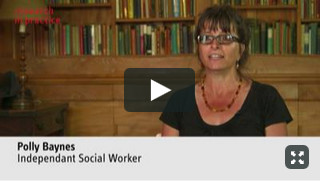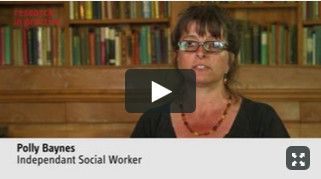 Contents
Contents
Ascertaining children’s wishes
- video: practitioners discuss making evidence-based decisions, good practice guidance on contact
- good practice documents
- links to relevant research, reviews and reports on the topic
- e-learning materials for this topic
What has changed?

Polly Baynes explains contact planning under the current policy framework
Running time: 01:35
Download video direct from Vimeo
Also viewable online via Adobe Connect
(having trouble playing our videos?)
Section 8 of the Children and Families Act 2014 and the Statutory Guidance on Court Orders and Pre-Proceedings place a duty on local authorities to:
- allow children in their care reasonable contact with their parents and certain other people. This amends the Children Act 1989 s34, which placed a duty on local authorities to promote contact
- balance the need to safeguard and promote the welfare of adopted children when making contact plans, considering the importance of the relationship and the potential for disruption.
The revised Statutory Guidance on Court Orders and Pre-Proceedings introduces a new way in which local authorities’ proposals for contact may be scrutinised or challenged, namely the role of the Independent Reviewing Officer in addressing the arrangements for contact during each review of the child’s care plan.
The role of contact in assessment
For children who are in care proceedings or where final decisions about their long-term future have yet to be made, observations of contact are an important part of assessment. However, it is important to remember that contact serves an important purpose for the child’s relationships – and is not just an opportunity for observation. If a parent or potential carer cannot interact well with a child during contact or attend reliably, plans for rehabilitation are unlikely to succeed.
Good quality contact is in itself an insufficient basis for returning a child to a parent’s care. Some parents can meet a child’s needs in the supported setting of contact but are unable to provide their day to day care because of other issues, such as substance misuse, difficulties in maintaining a home or risky relationships.
There is evidence that children who have regular and positive contact are more likely to be reunited with their birth parents, although this relates to a number of positive factors such as strong parent-child attachment and good social work support with parents[1] (i.e. it is not clear that high levels of contact, in themselves, lead to reunification).
References
- Biehal (2006) Reuniting Looked After Children with their Families: A review of the research.
Infants and contact
Polly Baynes discusses recent research on contact for infants
Running time: 03:44Download video direct from Vimeo
Also viewable online via Adobe Connect
(having trouble playing our videos?)
Historically, infants in care proceedings have been offered high frequency contact with birth parents on the basis that this will allow them to form an attachment. Increased understanding of attachment theory and the needs of young babies has challenged this practice. Important considerations for practice include:
- newborn infants need time to settle in placement and form an attachment with their primary carer – and this will be the foster carer in many instances. However, contact should be set at a level that allows the baby to begin to form a relationship with their parent at this stage – if the parent succeeds in making the changes necessary to allow the child to return home, contact can then be increased and incorporate higher levels of practical care, to allow an attachment to be built
- lengthy periods away from placement being transported (often by strangers) to contact of variable quality is not in the interest of very young children. Babies are acutely sensitive to face to face interaction
- protracted contact with parents who may be intoxicated, depressed, frightened, frightening or pre-occupied is harmful to infants. This is particularly important for infants who have been exposed to substance misuse or domestic violence in utero or experienced early neglect or maltreatment (as is the case for many babies involved in care proceedings2).
References
- Humphrey and Kiraly (2011) ‘High frequency family contact: a road to nowhere for infants’. Child and Family Social Work 16(1).
Contact during care proceedings
 Polly Baynes talks about the role of contact
Polly Baynes talks about the role of contact
Running time: 02:07
Download video direct from Vimeo
Also viewable online via Adobe Connect
(having trouble playing our videos?)
Contact during care proceedings provides a useful opportunity to:
- intervene with families
- improve relationships
- help parents learn more about how to meet their child’s needs.
This can support assessment of a parent’s capacity to change and learn, but is also a worthwhile aim in its own right. Establishing good quality contact in the short-term can:
- lay down positive shared memories for children who may be permanently separated from birth relatives
- support life story work
- provide an opportunity for parents to make reparation to children who have been harmed by maltreatment.
As well as supporting positive relationships with birth families, contact can help families to say goodbye and support parents to give children permission to settle in new families. Working to improve the quality of contact in the short-term can also provide a basis for more positive contact in the long-term, when children cannot go home to their birth families (Baynes, 2010).
Benefits of contact in permanent placement
For children in permanent placement, positive, reliable contact can help a child:
- maintain their sense of identity, and particularly for black children who are placed with white families
- learn more about their family history
- keep positive relationships alive
- be reassured that birth relatives are alright and that they have not been forgotten
- be kept informed of important changes at home3
- understand more about their parents’ strengths and weaknesses and reducing the risk of idealisation.
Given that most of the children who grow up in the care system resume contact with birth families in adulthood, contact can provide an important preparation for the realities of such future contact and help children learn to understand and manage any risks that their birth family may present to them or their own children.
In general, contact is most likely to benefit children when the relative concerned:
- has never been the child’s primary carer
- accepts and supports the placement
- relates positively to the child
- is relatively free of significant personal difficulties.
Positive factors relating to the child include:
- infant placement
- secure attachment
- the absence of significant behavioural or emotional difficulties
- a positive pre-placement relationship with the relative or no pre-placement relationship.
Positive factors relating to the carers include:
- sensitivity
- empathy
- communicative openness
- recognition of the importance of contact
- a positive attitude to the birth family4.
Sibling contact is often particularly important for children and may be manageable at higher levels when carers live relatively close by and have similar backgrounds and parenting styles. Contact with grandparents can be particularly beneficial.
References
- Schofield and Stevenson (2009) ‘Contact and Relationships between Fostered Children and their Birth Families’
- Neil and Howe (2004) Contact in Adoption and Permanent Foster Care. London: BAAF
Risks and difficulties associated with contact for looked after children
Children who have unsupervised contact with birth relatives who have previously abused them can be at risk of further maltreatment during contact4. Contact supervision can ensure children’s physical safety, but may not protect some children from emotional harm, particularly those who have been sexually abused or exposed to severe domestic violence5. In such cases, contact can serve to re-traumatise some children and undermine their trust in current carers (who they may see as failing to protect them by promoting contact). Other children may experience further rejection or neglect during contact, which can serve to perpetuate harmful relationships. Children may be distressed by evidence of their parents’ vulnerability if they attend contact with injuries, intoxicated or obviously unwell.
Parents may undermine the child’s placement or struggle to relinquish a parenting role. In extreme cases, parents may seek to locate a child’s placement with a view to abducting the child. Chains of contact may lead to the disclosure of confidential placement information or exposure to risky individuals. Siblings may discourage a child from settling in a new family, impede each others recovery or use contact to continue sexualised or abusive relationships.
Contact can be particularly difficult in kinship placements, partly because of a misplaced assumption that kinship carers should be able to manage these arrangements without professional support. Active social work support is needed to help such carers understand the potential risks and benefits of contact, make good decisions and protect the child. Professional supervision and access to venues and reviews of contact may also be needed.
Contact that is poor quality or problematic is associated with placement breakdown and further abuse for some children6.
References
- Macaskill (2002) Safe Contact? Children in permanent placement and contact with their birth relatives. Russel House Publishing
- Sturge and Glaster (2000) Contact and Domestic Violence: the experts’ report for the court. Family Law. 30
- Moyers, Farmer and Lipscombe (2006) ‘Contact with Family Members and its Impact on Adolescents and their Foster Placements’
Selwyn (2004) ‘Placing Older Children in New Families: Changing patterns of contact’
Contact and social media
Access to on-line information has changed the parameters of contact planning for ever. Many children who were in a placement before the invention of social media are now making contact with (or being contacted by) birth relatives in an unplanned way, often without the knowledge of their carers. For some, this contact can have benefits. For others, it may put them at risk. Additional care is needed in relation to identifying information shared in life story books.
Teenagers may be particularly vulnerable as they tend to be highly technologically literate, are naturally seeking independence from carers, may be highly emotionally pre-occupied with the idea of birth family as part of their search for identity and tend to respond impulsively to on-line requests. The use of parental controls and monitoring is of only limited use in protecting such children. More important is a culture of communicative openness in which young people feel able to talk to their permanent families about their natural curiosity and seek their support if wishing to make contact on-line.
Factors to consider when planning contact arrangements
The type and frequency of contact with the birth family should be determined by the purpose of contact and what is in the child’s best interest. Contact aimed at building a new relationship needs to be set at a relatively high level; contact aimed at maintaining an existing relationship can be less frequent; ‘identity contact’ aimed primarily at sharing information should be set at a low level. The overall pattern of contact for the child needs to be considered, ensuring that they have sufficient time to spend with their permanent family and regain their equilibrium between visits.
Research indicates that contact is often set at unsustainably high levels in long-term foster placements (monthly visits are generally too frequent)7. Annual visits have also been found to be difficult – this very low level of contact makes each visit too much of a big event. Contact at Christmas and birthdays is best avoided for many children, as these are emotive times.
Active social work intervention can help to promote good quality contact, including:
- work to prepare and support everyone involved
- careful involvement of carers and children in making and reviewing plans
- clear written agreements
- some financial support and access to good quality venues for activity based contacts
- actively facilitated rather than just supervised contact.
References
- Macaskill (2002) Safe Contact? Children in permanent placement and contact with their birth relatives. Russel House Publishing.
Ascertaining children’s wishes when planning contact
Children’s wishes regarding contact are important and need to be reviewed on a regular basis to reflect any changes to the child and family’s circumstances8. When ascertaining children’s wishes, remember:
- children want to keep in contact with many different members of their birth families, including parents, siblings, grandparents, uncles, aunts, cousins, nephews and nieces
- sometimes children want to keep in touch with people who are not actually relatives, but are close friends of their birth families9
- children may ask for higher levels of contact than they can cope with emotionally 10. Children may express complex, conflicting and changeable feelings around contact
- Feelings of loyalty may make it difficult for children to ask for contact to be changed or stopped.
It is important that children’s verbally expressed wishes are viewed in the context of a broader understanding of their history and family relationships, careful observation of contact visits and discussion with carers about the impact on the child before and after contact.
References
- Moyers ET AL (2006) ‘Contact with Family Members and its Impact on Adolescents and their Foster Placements’
- Morgan (2009) Ofsted – Keeping in touch. A report of children’s experiences from Ofsted via the National Archives
- Morgan (2009) Ofsted – Keeping in touch. A report of children’s experiences (p.9) from Ofsted via the National Archives
Further reading
- Baynes P (2010) ‘Interim Contact during Care Proceedings’. Seen and Heard, 33-42
- Biehal N (2006) Reuniting Looked After Children with their Families: A review of the research. London: National Children’s Bureau
- Burnell A, Castell K and Cousins C (2009) Siblings together or apart. Family Futures Practice Paper Series. London: Family Futures
- Humphreys C and Kiraly M (2011) ‘High-frequency Family Contact: A road to nowhere for infants’. Child & Family Social Work 16 (1) 1-11
- HM Governmnet (1989) The Children Act 1989
- HM Government (2014) Children and Families Act 2014
- Loxtercamp L (2009) ‘Contact and Truth: The unfolding predicament in adoption and fostering’. Clinical Child Psychology and Psychiatry 14 (3) 423-435
- Macaskill C (2002) Safe Contact? Children in permanent placement and contact with their birth relatives. Dorset: Russell House Publishing.
- Morgan R (2009) Keeping in Touch. A report of children’s experience by the Children’s Rights Director for England. London: Ofsted
- Moyers S, Farmer E and Lipscombe J (2006) ‘Contact with Family Members and its Impact on Adolescents and their Foster Placements’ British Journal of Social Work 36 (4) 541-559
- Neil E and Howe D (2004) Contact in Adoption and Permanent Foster Care. London: BAAF
- Neil E, Beek M & Ward E (2014) Contact after Adoption: a longitudinal study of adopted young people and their adoptive parents and birth relatives. London: BAAF.
- Neil E, Cossar J, Jones C, Lorgelly P and Young J (2011) Supporting Direct Contact after Adoption BAAF; London
- Sturge C and Glaster D (2000, September) ‘Contact and Domestic Violence: the experts’ report for the court’. Family Law
- Schofield G and Simmonds J (2011) ‘Contact for infants subject to care proceedings’. Family Law, June 2011
- Schofield G and Stevenson O (2009) ‘Contact and Relationships between Fostered Children and their Birth Families’ in Schofield G and Simmonds J (eds) The Child Placement Handbook: Research, policy and practice. London: BAAF
- Selwyn J (2004) ‘Placing Older Children in New Families: Changing patterns of contact’ in Neil E and Howe D (eds) Contact in Adoption and Permanent Foster Care: Research, theory and practice. London: BAAF
- Sen R and Broadhurst K (2011) ‘Contact between Children in Out-of-home Placements and their Family and Friends Networks: A research review’. Child & Family Social Work 16 (3) 298-309
- Sinclair I (2005) Fostering Now: Messages from research. London: Jessica Kingsley Publishers
Learning resources
 Anthony Douglas, CBE, CafCass: good practice guidance on contact
Anthony Douglas, CBE, CafCass: good practice guidance on contact
Running time: 00:38
Download video direct from Vimeo
Also viewable online via Adobe Connect
(having trouble playing our videos?)
 Polly Baynes talks about making evidence-based decisions
Polly Baynes talks about making evidence-based decisions
Running time: 04:03
Download video direct from Vimeo
Also viewable online via Adobe Connect
(having trouble playing our videos?)
Cafcass/ADCS have published a good practice guidance note on contact as one of its downloads.
Online learning resources for practitioners working on making positive post-adoption contact plans and supporting birth relatives and adopters through contact planning for their child can be found on the Contact after adoption site (open access), developed by Research in Practice and Prof Beth Neil from University of East Anglia.
The Fostering Network has produced a range of tools and resources as part of its Heart of the Matter project around supporting contact for children placed in foster families. These include:
Also see:
Test your knowledge
These exercises aim to help you embed knowledge in this area. A range of different formats have been used, and most can be used individually or in team learning. Discussing your learning with your supervisor will help to ensure it informs your practice
Start test







